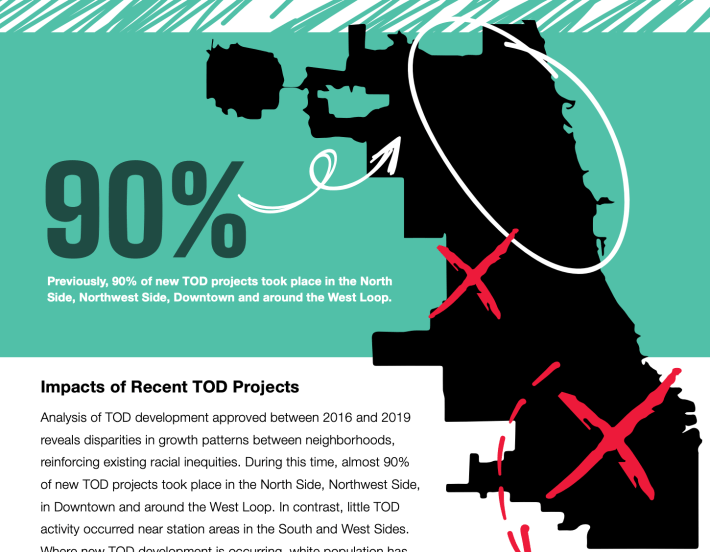While transit-oriented developments -- high-density, parking-lite housing near rapid transit stations -- has become increasingly common in Chicago over the last few years, most of the projects have been upscale buildings in affluent or gentrifying neighborhood downtown or on the North and Northwest Side. A new equitable transit-oriented development plan published by the city today lays out steps for bringing affordable TOD to all parts of town, so that people of all incomes can enjoy the mobility, economic, and health benefits of living near transit in walkable communities.
According to the city, the 2020 eTOD Policy plan was create "to address the market failures... [that] have led to (1) the lack of dense and walkable housing and retail development around CTA and Metra stations in Black communities on the South and West sides, and (2) displacement pressure being felt by long-time residents living near CTA stations in other parts of the city that have been experiencing exponential growth."
The plan was mandated by the city’s 2019 amendment to the Chicago TOD ordinance, originally approved by City Council in 2013, which required the city to study disparities in the TOD ordinance performance and propose updates to encourage more equitable development. The city says the new plan "updates earlier TOD efforts and offers a roadmap for mixed-use neighborhood development around CTA and Metra stations and high-capacity bus routes that are walkable and pedestrian-oriented to mitigate the effects of residential housing segregation, build community wealth, improve climate resiliency and the overall health of residents."
"Every Chicagoan, no matter what side of the city they reside on, should have access to both our world-class transportation system and the recreational, housing, and environmental benefits that come with it," said Mayor Lori Lightfoot in a statement. "The new eTOD Policy Plan will expand this access and give our most disinvested neighborhoods the long-overdue opportunity to enjoy these benefits while not being forced out of the community they call home. I look forward to working closely with our departments of transportation, planning and development, and other key stakeholders as we take this next step to bring the values of equity and inclusion into our urban development agenda."
The city notes that equitable TOD can address disparities in health and life expectancy in a city where Black residents live an average of nine years fewer than their white counterparts.
“We support the city’s effort to establish this plan, which complements the inherent nature of public transit as an equalizer -- allowing anyone at any time to travel anywhere in the city for a low, flat fare,” said CTA president Dorval Carter in a statement. “Incentivizing development near rail lines with unused capacity will make our city less car-dependent and more resilient, as well as contributing to ridership and revenue growth for the city’s transit system.”
The city says that more than 200 TODs have been approved since late 2016, but about 90 percent of these projects have been located in wealthier or gentrifying parts of town. "Those neighborhoods surrounding TODs are experiencing population increases and additional private investment and development, while in Black communities where TODs are not common, the population is decreasing as residents move to areas where access to transit and other amenities are better. In some Latinx neighborhoods, such as Pilsen, TOD activity is occurring, however, the growth is so accelerated that many residents are being displaced."

The stated goal of the plan is to encourage development in Black and Brown communities while protecting current residents from housing displacement. Here are some of the strategies proposed for the next three years.
- Building the city’s internal capacity infrastructure, including the formalization of an eTOD workgroup for cross-sector and inter-agency coordination as well as standardizing community engagement practices to elevate community voice in decision making.
- Making eTOD a requirement and easier to accomplish, including through creating and preserving affordable housing near transit, promoting transit, walking and biking options, and supporting small businesses growth.
- Embedding eTOD into Chicago’s “We Will” Citywide Planning initiative through incorporating health, equity and safety criteria into land-use planning and zoning decisions.
“It’s clear that both real estate developers and building tenants appreciate the benefits of transit-served economic development and housing projects,” said DPD commissioner Maurice Cox said in a statement. “This effort will help eTOD become more prevalent in portions of the city where the transit resources exist, but development doesn’t.”
“As we work toward filling the city’s affordable housing gap, the Equitable Transit-Oriented Development policy plan will increase and encourage the opportunities, investment and wealth-building communities need to grow, while at the same time prevent long-time residents from being displaced,” said DOH commissioner Marisa Novara.
According to the city, a diverse eTOD working group with more than 80 members was created in 2019 that includes representatives from the planning, housing, public health, and transportation departments and the CTA, along with reps from from community organizations, the private sector, philanthropy, and regional nonprofit groups and governmental officials. The city says the working group, in partnership with Elevated Chicago, drafted the eTOD plan through a cross-sector engagement process and analysis of current city policies and programs using an evaluation framework focused on equity, outcomes, and implementation criteria with the ultimate goal of closing the socioeconomic gaps between neighborhoods and improving overall quality-of-life.
The 2020 eTOD report is available by visiting chi.gov/etod. Residents can submit their comments to etod@cityofchicago.org through Thursday, October 29.
Streetsblog Chicago will provide commentary on the plan in the near future.
Follow John Greenfield on Twitter at @greenfieldjohn.





